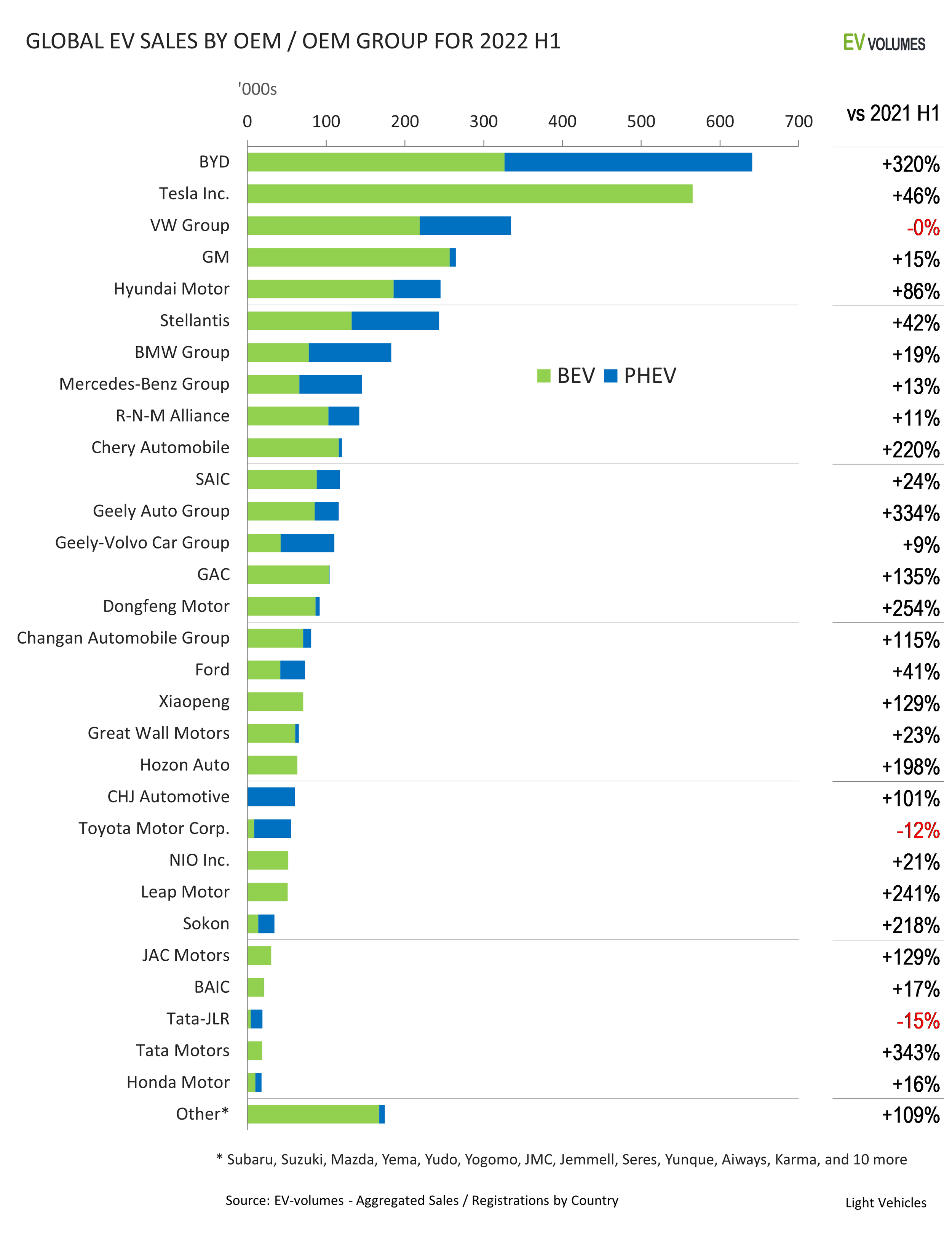Global EV Sales for 2022 H1
Originally posted on Ev-volumes.com/
By Roland Irle, EV-Volumes
Global EV sales continue strong. A total of 4,3 million new BEVs and PHEVs were delivered during the first half of 2022, an increase of +62 % compared to 2021 H1. The regional growth pattern is shifting, though. Following 2 years of steep sales increases in Europe, EVs gained only +9 % over 2021 H1 there. Weak overall vehicle markets and persistent component shortages have taken their toll, exacerbated by the war in Ukraine. EV sales in USA and Canada increased by 49 % for H1 year-on-year, despite a weak overall light vehicle market which plunged by 17 % during H1 y/y.
China NEV sales defied all challenges the country is facing otherwise (real estate crisis, Covid lock-downs) and increased by a staggering 113 % for H1. BYD more than quadrupled sales to 641 000 units, making it the #1 in the global sales ranking, if their 315 000 PHEV sales are included. Counting BEVs only, Tesla still leads by a wide margin with 565 000 units delivered in H1.
PHEVs stood for 27 % of global Plug-in sales in 2022 H1 compared to 29 % in 2021. While their sales volumes still increase, their share in the PEV mix is in decline, facing headwinds from incentive cuts and improving BEV offers. Sales growth is increasingly depending on the degree of electrification. While BEVs grew by +75 % and PHEVs by +37 %, non-chargeable Full Hybrids grew by +14 % and Mild Hybrids backed by -7 % y-o-y H1. ICE-only vehicle sales declined by -16 %. Total global light vehicle sales were down 8 % y/y for H1-2022.
Rapid EV adoption in weak auto markets has boosted EV shares further. BEVs (8,2 %) and PHEVs (3,1 %) stood for 11,3 % of global light vehicle sales at H1 close, compared to 6,3 % in 2021 H1. Norway had the highest market share of EVs in H1 (BEV 69 % + PHEV 8 %), China had 21 %, Europe 18 % and USA 6,5 %. The fastest growing markets were India with 20 700 units BEV & PHEV for H1, +273 % and New Zealand with 8 300 units, +260 %.
For the full year of 2022, we expect sales of 10,6 million EVs, a growth of 57 % over 2021, with BEVs reaching 8 million units and PHEVs 2,6 million units. By the end of 2022 we expect nearly 27 million EVs in operation, counting light vehicles, 70 % are BEVs and 30 % PHEVs. Sales of Fuel Cell Vehicles (FCEV) in the light vehicle sector have declined by -9 % so far and are below 20 000 units annually. Current sales are from 5 vehicle models and most sales are in South Korea and USA. We estimate their current population to ca 55 000 units.
High EV Growth in Weak Vehicle Markets
Global light vehicle markets are contracting again. Following a brief recovery in 2020 H2 and 2021 H1, 2022 H1 sales were 8,1 % lower than last year. We expect small gains for H2 as numbers compare to the depressed sales of 2021 H2. 2022 auto sales in most mature markets stayed 20-30 % below the 2015 - 2019 average, so far.
China is among the few exceptions, but with extreme volatility: a +24 % increase y/y in February was followed by a -45 % crash during the April lock-downs and a +30 % boom in June and July, amid swift Government support.
Western auto sales are facing a double dip, post-Covid, with supply constraints soon to be joined by demand constraints as central banks try to combat inflation by interest rate hikes. The result is, much likely, a further delay in market recovery.
EV sales held up well in this environment: while global light vehicle sales lost -8,1 %, BEVs and PHEVs increased by +62 % for H1. The relative weakness in Europe's EV growth relates to the EV boom in 2020 / 2021 and the repercussion from the war in Ukraine.
New all-time-highs in EV sales will be common also during the 2nd half, but growth rates will be somewhat lower as the low-base-effect diminishes.
BYD Leads - Including Plug-in Hybrids
Robust increases of EV sales enabled nearly all OEM to grow their sales in 2022-H1. Global EV deliveries increased by +62 % y/y in total; OEMs with higher growth have increased their share in the EV sector.
BYD sold over 4 times as many BEVs+PHEVs compared to 2021 H1, by boosting sales of existing models, successfully introducing new models and by entirely focusing production and sales on BEVs and PHEVs. Non-chargeable variants were phased out, ending in April this year. BYD is now the largest maker of PHEVs and moved from rank #3 in 2021 to #1 for BEVs & PHEVs combined.
Tesla leads global sales of BEVs by a large margin, with a share of 18 % in all BEVs sold worldwide. H1 growth was 46 %, less than for the sector, but from a high base.
The VW Group stayed flat compared to last year; with all its brand following this pattern we can assume production related issues. BEVs gained, while PHEVs lost.
GM increased by just 15 % as the Wuling Mini-EV is facing more competition and most future, high volume EV entries still are in the pipeline.
Hyundai and Kia launched at least 9 new and revised EVs during the last 18 months, among them the Ioniq 5, the Kia EV6, the Kia Niro and 3 EVs from Genesis. Their global growth outperforms the sector and is the more impressive as the companies EV presence in China is fading.
Increases of Stellantis were below the global EV sector growth, with high exposure to slow growing Europe and low sales in the strongest market, China. Excluding China, their sector share has risen from 11 % in H1-2021 to 12,7 % this year.
Other OEMs of European and/or Japanese origin did not keep up with the sector growth as they were held back by disturbed supply chains and/or underestimated EV demand during weakening auto markets. Toyota and Jaguar Land Rover delivered fewer EVs compared to last year.
Most Chinese brands show triple digit growth of NEV sales in their booming home-market. Exports accounted for only 3,6 % of their global volume, not including China exports by e.g Tesla, Polestar, BMW iX3 and other transplants. Including these, exports accounted for 8,4 % of China NEV production in H1 this year.




